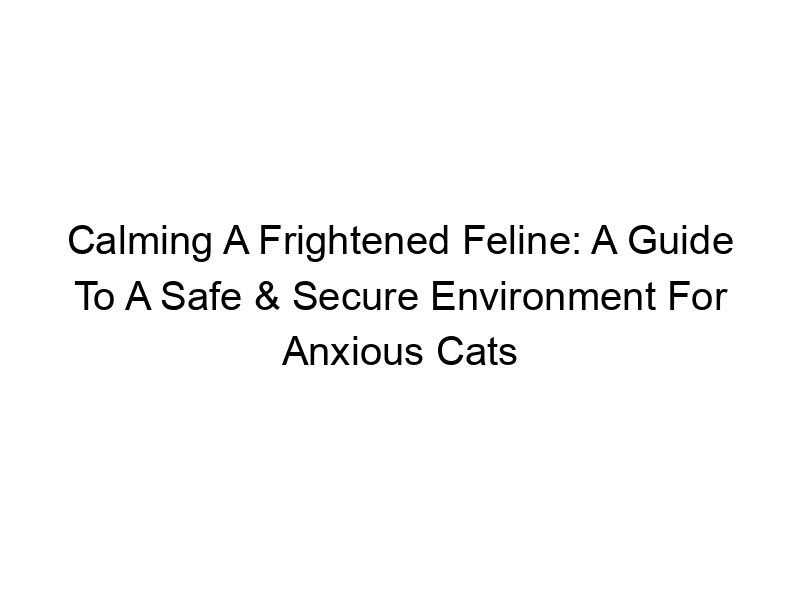Is your cat constantly hiding, hissing, or showing other signs of fear and anxiety? Understanding and addressing your cat’s anxieties is crucial for their well-being. This comprehensive guide will explore How to Help a Scared or Anxious Cat Feel Safe, covering everything from identifying the root causes of fear to implementing practical solutions for creating a secure and comforting environment. You’ll learn about behavioral modification techniques, environmental enrichment, and the role of veterinary care in managing feline anxiety.
Cats express fear and anxiety in various ways, including hiding, hissing, growling, flattened ears, dilated pupils, excessive grooming, changes in appetite, and urination outside the litter box. Understanding these subtle cues is the first step to helping your cat.
Several factors can trigger anxiety in cats, including loud
noises (thunderstorms, fireworks), changes in their environment (new furniture, moving house), unfamiliar people or animals, and underlying medical conditions. Past trauma can also significantly contribute to chronic anxiety.
Creating a Safe and Secure Space
Designing a Cat-Friendly Sanctuary
Creating a safe haven for your anxious cat is paramount. This space should be quiet, dark, and easily accessible, providing a sense of security and control. Consider a cat tree, a comfortable bed, and plenty of toys and scratching posts within the sanctuary.
Environmental Enrichment: A Key to Reducing Anxiety
Enriching your cat’s environment helps to reduce stress and boredom, which can exacerbate anxiety. Provide vertical space (cat trees), interactive toys (puzzle feeders), and regular play sessions to stimulate your cat’s natural instincts.
Minimizing Stressors: A Practical Approach
Identify and minimize potential stressors in your cat’s environment. This might involve using pheromone diffusers (Feliway), providing a secure hiding spot during stressful events like thunderstorms, and gradually introducing new people or animals.
Behavioral Modification Techniques
Positive Reinforcement Training: A Gentle Approach
Positive reinforcement is a humane and effective method for modifying fearful behaviors. Reward calm behavior with treats, praise, or petting, and gradually introduce your cat to anxiety-provoking situations at their own pace.
Desensitization and Counter-Conditioning: Gradual Exposure
Gradually expose your cat to their fears in a controlled manner. Start with a minimal exposure and reward calm behavior. Slowly increase the intensity of exposure as your cat becomes more comfortable. This process takes patience and consistency.
Clicker Training: A Powerful Tool
Clicker training utilizes a clicker sound to mark desired behavior, followed by a reward. This technique can be particularly effective in teaching cats new behaviors and reducing fear-related responses.
The Role of Veterinary Care
Consulting a Veterinarian: Essential for Diagnosis and Treatment
If your cat’s anxiety is severe or persistent, consult your veterinarian. They can rule out any underlying medical conditions, assess the severity of the anxiety, and recommend appropriate treatment options.
Medication for Feline Anxiety: When Necessary
In some cases, medication may be necessary to manage severe anxiety. Your veterinarian will discuss various options, including antidepressants and anxiolytics, and help you determine the best course of action for your cat.
Pheromone Therapy: A Natural Approach
Pheromone diffusers and sprays (Feliway) mimic feline facial pheromones, creating a calming effect. These products can be helpful in reducing anxiety in some cats, especially in stressful situations.
Understanding Cat Body Language
Decoding Feline Communication: Recognizing Signs of Fear
Learning to interpret your cat’s body language is crucial in understanding their emotional state. Understanding subtle cues like flattened ears, tucked tail, or wide eyes can help you identify when your cat is feeling scared or anxious.
Responding Appropriately to Fearful Behavior
Avoid forcing interaction with a frightened cat. Instead, provide a safe space, minimize disturbances, and offer gentle reassurance from a distance. Forcibly handling a scared cat can worsen their anxiety.
Utilizing Technology to Create a Safer Environment
Smart Home Technology: Enhancing Security and Monitoring
Smart home devices, such as pet cameras and automated feeders, can provide monitoring and a sense of control, particularly helpful for cats experiencing separation anxiety.
Creating a Calming Atmosphere with Ambient Lighting and Sounds
Soft lighting and calming music can significantly reduce anxiety in cats. Creating a soothing atmosphere contributes to a more secure and relaxed environment.
Comparative Analysis of Anxiety Relief Methods
Different Approaches: Evaluating Effectiveness and Suitability
Different methods work best for different cats. Some cats respond well to pheromone therapy, while others may require medication or behavioral modification techniques. Your veterinarian can help determine the most effective approach for your individual cat.
Weighing the Pros and Cons: A Balanced Perspective
Each method has its advantages and disadvantages. Medication can be highly effective but may have side effects. Behavioral modification requires patience and consistency. Weighing the pros and cons of each approach will help you choose the best strategy.
Setting Up a Safe Environment: Step-by-Step Guide
Step 1: Identify Stressors
First, identify the triggers for your cat’s anxiety. Observe your cat’s behavior and note any patterns or triggers.
Step 2: Create a Safe Haven
Establish a dedicated safe space for your cat, free from stressors. This space should be quiet, dark, and comfortable.
Step 3: Introduce Calming Aids
Consider using pheromone diffusers, calming music, or soft lighting to create a more relaxing atmosphere.
Troubleshooting Common Challenges
Dealing with Persistent Anxiety: Persistent Strategies
If anxiety persists despite implementing strategies, consult a veterinarian or a certified cat behaviorist. They can offer specialized guidance and support.
Addressing Relapse: Maintaining Consistency
Consistency is key in managing feline anxiety. Even after significant improvement, continue to maintain a safe and enriched environment and follow recommended strategies.
Frequently Asked Questions
What are the early signs of anxiety in cats?
Early signs include changes in litter box habits, excessive grooming, hiding, changes in appetite, and increased vocalization.
Can I use essential oils to calm my anxious cat?
Use caution with essential oils, as many are toxic to cats. Consult a veterinarian before using any essential oils around your cat.
How long does it take for anxiety medication to work?
The timeframe varies depending on the medication and your cat’s response. It can take several weeks to see noticeable improvement.
Are there any natural remedies for cat anxiety?
Natural remedies like Feliway diffusers and calming music can be helpful, but consult your veterinarian before using any supplements or home remedies.
How can I help my cat adjust to a new environment?
Introduce your cat gradually, provide a safe space, and use calming aids. Allow your cat to explore at their own pace.
Final Thoughts
Helping a scared or anxious cat feel safe is a journey requiring patience, understanding, and consistent effort. By implementing the strategies outlined in this guide—creating a secure environment, employing positive reinforcement training, and consulting with veterinary professionals—you can significantly improve your cat’s well-being and foster a stronger, more loving bond. Remember, every cat is unique, and finding the right approach may involve experimentation and adjustments. Don’t hesitate to seek professional help if needed—a calm and confident cat is a happy cat. Start creating a safer, more enriching environment for your feline friend today.




